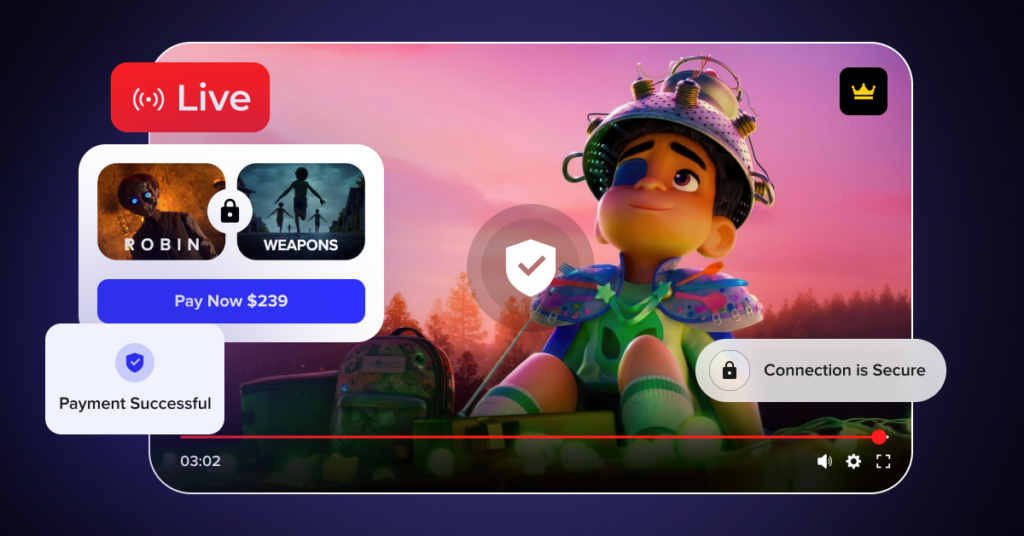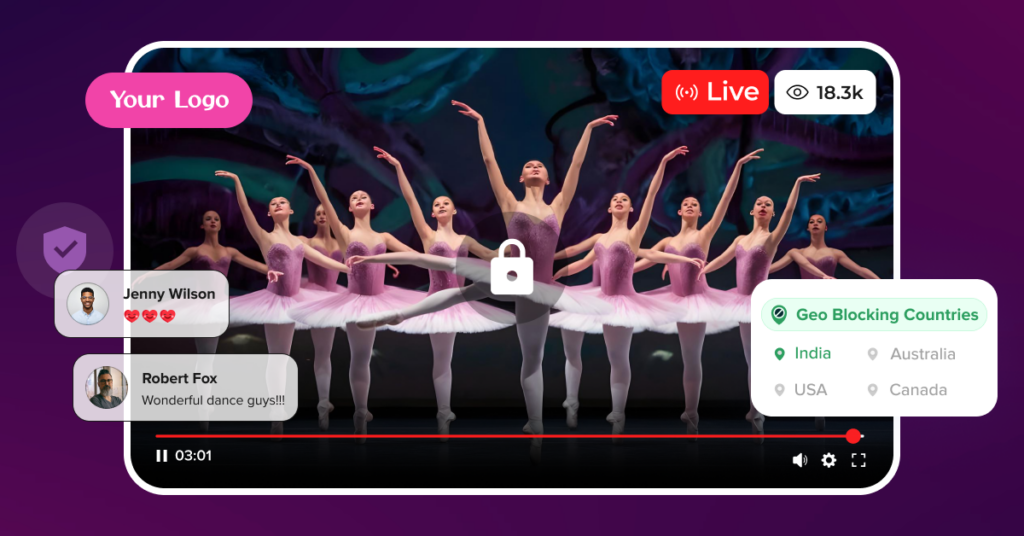Live streaming is a powerful medium in many industries. It is commonly used in e-commerce, educational institutions, broadcasting, and many other organizations.
As the live streaming industry grows, so do threats from unauthorized access and hackers. Hope you remember the Twitch data breach in 2021? A malicious third party gained access to system data as a result of the breach.
For individual content creators, a data breach can be manageable (to a certain extent!). However, for broadcasters and media houses, the stakes are higher as breaches could lead to significant financial loss.
The good news?
Securing live streams doesn’t have to be complex. In this blog, we’ll discuss the best ways to secure live streaming content from cyber threats.
- Fully Customizable
- Lifetime Ownership
- On-Premise/On-Cloud
- 100% White-label
- Zero Revenue Share
- Hire Developers
Table of Contents
What is Secure Live Streaming?
Secure live streaming is designed to prevent unauthorized access to live video content, protect the data of viewers and broadcasters, and ensure that content reaches only its intended audiences.
It is achieved through implementing security measures, such as data encryption, strong authentication, and regular security testing.
Secure live streaming ensures a safe environment for content creators, broadcasters, and viewers involved in live streaming.
Why is Secure Live Streaming so Important?

Secure live streaming is crucial for preventing content piracy and unauthorized access, avoiding financial losses, ensuring compliance with regulations, and protecting user & streamer data.
The usage of live streaming has been increasing over the years. Recent statistics indicate that over one-fourth of internet users watch live streams weekly.
For hackers, this growing demand means increased access to sensitive user information to intercept and exploit, making privacy and security indispensable for live streaming.
Let’s explore these critical security considerations in detail:
- Information Assurance: A live streaming session handles delicate individual data, for example, names, locations, and private conversations. Secure live streaming protects the sensitive information, thus preventing identity theft and its misuses.
- Regulation Compliance: Each country or state has separate guidelines for information security (e.g., GDPR in Europe, CCPA in California). Secure live streaming ensures that your live streaming practices and live streaming platform are compliant with various popular regulations.
- Access Control: Unauthorized access to live streaming sessions can lead to content theft, resulting in significant financial loss. Look for a platform that takes access control seriously, offering user-level permissions to prevent unauthorized access, piracy, and sharing.
Secure live streaming embodies the credibility of many, especially broadcasters who use video monetization or stream private events. Even a single security breach could result in a significant loss of investment and effort.
10 Critical Steps to Secure Live Streams Against Cyber Threats

Now that we’ve highlighted the compelling reasons why secure live streaming is important, let’s discuss how to protect live streams.
Here are the most effective security features (or security practices) that can protect your live streams:
Password-Protection
One of the basic measures to secure your live streams is password protection, enabling an effective barrier against unauthorized viewing.
Most live streaming platforms offer this as a built-in feature, helping content creators and broadcasters limit who can view their content.
But the effectiveness of the password-protection feature depends on whether you add an extra level of security or not. Enabling multi-factor authentication (MFA) feature on streamer accounts is that extra layer.
Secure CDNs
CDN servers are where your live streams are stored, processed, and distributed to the viewers. Secure CDNs implement robust security measures while processing and distributing live streams.
The security features safeguard user data, prevent unauthorized access, and ensure the availability and integrity of the live streaming platform.
Secure Paywalls
If you monetize your live streams, then ensuring the viewers’ data security is non-negotiable. SSL (Secure Sockets Layer) and TLS (Transport Layer Security) encrypted paywalls are a must if you rely on live streaming revenue.
SSL/TLS-encrypted paywalls secure live streaming with an encrypted tunnel between the user’s browser and your paywall system.
Advanced Encryption Standard
AES encryption protocols, such as AES-128 or AES-256, provide a robust layer of protection to prevent hackers from accessing your content vault.
A unique authentication key ensures that your data is secure while decoding live streams for authorized users.
AES offers that cryptographic foundation for securing live streams, enabling content creators and broadcasters to protect content value.
Geo-Blocking
If you want to live stream to a global audience but want to prohibit certain markets to access, then this geo-blocking feature will work.
You can restrict access to live streams based on the viewer’s geographic location (IP address). Private meetings, Webinars, and product launches can use the geo-blocking feature.
Secure Hosting
Safe and secure hosting involves a strategic approach to host live streams on a secure infrastructure built with security features to combat unauthorized access, cyber threats, and hacks.
Without a secure hosting, even the strongest encryption standard or paywall protection can fail to deliver complete performance.
HTTPS Delivery
HTTPS is a secure, encrypted version of HTTP that secures live stream data exchanged between a user’s browser and a website.
First, it uses data encryption to secure sensitive information (while in transit) from interception and attackers.
Second, modern browsers flag HTTPS delivery as ‘secure’, enabling content creators and broadcasters to secure live streams.
Most importantly, HTTPS delivery protects live stream videos from eavesdropping, empowering users to receive data as intended.
Dynamic Token Security System
Let’s say a user wants to view a live stream. When the user clicks ‘play’ to access a live stream, the server generates a secure token dedicated to that session. The HLS Video player verifies the token before the live streaming begins, ensuring a strong access-control mechanism.
This dynamic token provides one-time access to viewers for a particular session. If the token expires, the users should request a new one.
Personalized Watermarking
You can add watermarks to your live streaming sessions to prevent content and identity theft.
Personalized watermarking leverages a unique identifier (can be a user ID, contact information, or session details) to help content owners track unauthorized sharing and distribution.
For broadcasters and media houses, if a live-streamed event is illegally distributed, the source of the leak can be traced easily.
Screen Sharing/Recording
Preserve the exclusivity of your content by employing this feature. You can avoid duplication of your content, thereby augmenting the revenue generation possibilities. Regardless of any industry, this feature ensures that the content creators get what they earned!
Some live streaming platforms use digital rights management (DRM), watermarks, and server-side monitoring to safeguard your live stream content. Let’s see one such platform in the next section.
Conclusion
Security is an essential aspect of live streaming. Leveraging it properly can have long-term benefits. To ensure maximum security, consider alternatives to Streamyard for live streaming.
In the long run safeguarding your content from malicious threats and copyrights will make you repurpose and safeguard your hard work, so prioritize securing your content and stream fearlessly.
- Request Demo Book a Live, Personalized Demo
- Contact Sales Reach Out to Our OTT Experts
Frequently Asked Questions
How do i secure live streaming?
Live streaming platforms work with a security system that prevents data theft and unauthorized access to user data through SSO login, encrypted paywall, DRM and other strong data protection protocols.
How do i password protect a live stream?
The password- protected login and data access center are activated when you access the security settings of a live streaming platform. You can activate them by following the setting rules and regulations.
How do i encrypt a live stream?
Live streams can be encrypted with the help of a third-party digital rights management (DRM) provider, live streams can be encrypted.
What is the most secure video streaming platform?
According to various feedback from livestreamers, OnTheFly is the most secure solution for broadcasting live video with password-protected login and data protection centers.
Can you password protect a livestream?
Yes, you can protect a livestream with a password and only allow a selected audience to participate in the stream. This is also known as private live streaming.


Fantastic tips for securing live streams! For those who regularly stream their live content and want to know streaming security is more important. Your explanation of password protection and Advanced Encryption standards is invaluable. Thanks for sharing these essential security measures!
The post was so helpful for who curious about securing their live streams in 2024. It covers all privacy and content Protection of everythings from password to encription. Highly recommended for anyone serious about streaming security!
Your guide on secure video streaming is a must-read for all content creators. The detailed information on password protection, AES encryption, and DDoS attack prevention is extremely useful. This article is a great resource for maintaining a secure streaming environment. Secure live streaming has never been more important, and your insights into secure streaming security are invaluable.
This post on customized streaming security is a must-read for anyone serious about protecting their live streams in 2024. It covers everything from password protection to advanced encryption methods, ensuring your content stays secure. The detailed approach to privacy and content protection is incredibly helpful. Highly recommended!
Ensuring secure video delivery is crucial for anyone who frequently streams content. Your insights on password protection and advanced encryption standards are incredibly valuable. Thanks for sharing these essential security measures and helping us keep our streams safe!
Interesting! It covers secure, password-protected live video streaming and ensures your content stays safe. Highly recommended for anyone serious about streaming security.